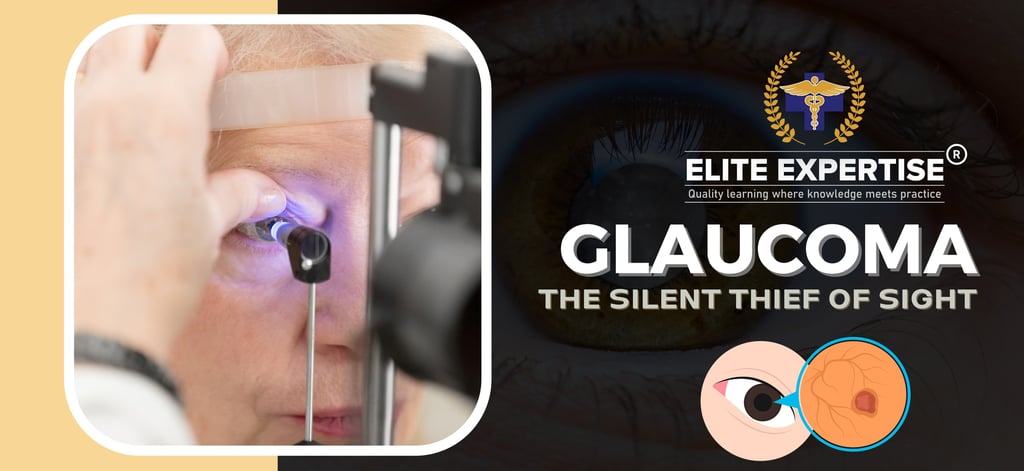ASK MY PHARMACIST | GOT QUESTIONS? Your pharmacist has answers. Click Here
Glaucoma: The Silent Thief of Sight | Causes, Symptoms & OPRA Exam Guide
Glaucoma, the silent thief of sight, is a top cause of blindness. Learn its types, symptoms & treatments—vital for eye health.
Sahana
3/2/20255 min read


What is Glaucoma?
A group of eye disorders known as glaucoma damages the optic nerve, usually resulting in vision loss and blindness. The treatment should not be neglected. This is the second most occurring cause of blindness globally. Usually developing without obvious symptoms in its early stages, glaucoma is referred to as the "silent thief of sight," thus regular eye exams are crucial for early identification and treatment. This is one of the important topics in all the licensure exams, like the OPRA exam (Australia, New Zealand), the PEBC exam (Canada), the PSI equivalence exam (Ireland), and so on.
Types of Glaucoma
Glaucomas most often occurring type is:
1. Primary Open-Angle Glaucoma (POAG)
This is the most commonly occurring kind of glaucoma. It occurs as the eye's drainage canals gradually clog over time. This leads Raised intraocular pressure (IOP) follows from this. Most people will not be able to detect any early-stage symptoms, as this process occurs quite slowly. There will have been notable damage by the time the patient encounters vision issues. Regular eye exams help to prevent this and help to control the matter before any major damage results.
2. Angle-Closure Glaucoma
Also called closed-angle glaucoma, this condition results from a sudden rise in eye pressure brought on by a blocked drainage angle in the eye. Considered a medical emergency, this needs quick treatment to stop lifelong vision loss.
3. Normal-tension glaucoma
In this condition, the optic nerve is damaged despite normal eye pressure levels. The exact cause is not well understood, but factors such as reduced blood flow to the optic nerve may play a role.
4. Glaucoma from Birth
Because of aberrant eye development, this rare type affects infants and young children. 4. Congenital Glaucoma


Causes and Risk Factors
Glaucoma is primarily caused by increased intraocular pressure, which can damage the optic nerve. However, several risk factors can contribute to its development, including:
• Age: People over 60 are at a higher risk.
• Family History: A genetic predisposition increases the likelihood of developing glaucoma.
• Ethnicity: African Americans, Hispanics, and Asians have a higher risk of certain types of glaucoma.
• Medical Conditions: Conditions like diabetes, high blood pressure, and heart disease may increase the risk.
• Prolonged Use of Steroids: Long-term use of corticosteroids, particularly eye drops, may contribute to glaucoma development.
Symptoms of Glaucoma
In the early stages, glaucoma often has no noticeable symptoms. However, as the disease progresses, patients may experience:
• Loss of peripheral (side) vision
• Blurred vision
• Seeing halos around lights
• Eye pain and redness (especially in angle-closure glaucoma)
• Headaches and nausea (in acute cases)
Diagnosis and Treatment
Diagnosis
Regular eye exams are crucial for detecting glaucoma early. Common diagnostic tests include:
• Tonometry: measures intraocular pressure.
• Ophthalmoscopy: Examines the optic nerve for damage.
• Perimetry (Visual Field Test): Assesses peripheral vision loss.
• Gonioscopy: evaluates the drainage angle in the eye.
Treatment Options
While glaucoma cannot be cured, treatments can help slow its progression and preserve vision. These include:
1. Medications
Prescription eye drops are often the first line of treatment to reduce intraocular pressure by improving fluid drainage or decreasing fluid production.
2. Laser Therapy
Laser treatments, such as trabeculoplasty for open-angle glaucoma and iridotomy for angle-closure glaucoma, can help improve fluid drainage.
3. Surgery
For advanced cases, surgical procedures like trabeculectomy or implantation of drainage devices may be necessary to lower eye pressure.
Prevention and Eye Health Tips
While glaucoma cannot always be prevented, certain steps can reduce the risk or slow its progression:
• Regular Eye Exams: Early detection is key to preventing severe vision loss.
• Maintain a Healthy Lifestyle: Exercise, a balanced diet, and avoiding smoking can contribute to overall eye health.
• Protect Your Eyes: Wear protective eyewear to prevent injuries that could increase glaucoma risk.
• Follow Doctor’s Recommendations: Adhering to prescribed treatments and medication schedules is essential for managing the condition.
Conclusion
Glaucoma is a serious, progressive eye disease that can lead to permanent vision loss if left untreated. Since it often develops without early symptoms, regular eye check-ups are essential for early detection and intervention. Understanding glaucoma’s causes, risk factors, symptoms, and treatment options is not only crucial for maintaining good eye health but also vital for medical professionals preparing for the OPRA exam.
For those studying for the OPRA exam or other medical licensure tests, mastering glaucoma-related concepts is essential. Questions about glaucoma diagnosis, treatment, and risk factors frequently appear in these exams, making in-depth knowledge key to success.
If you are a healthcare professional or a student preparing for the OPRA exam, ensure you stay updated on the latest guidelines and treatment protocols. Awareness, early diagnosis, and proper management can help prevent blindness and ensure better patient care.
Frequently Asked Questions (FAQs) on Glaucoma
Q1: Can glaucoma be cured?
A: No, glaucoma cannot be cured. However, early detection and treatment can help slow its progression and prevent significant vision loss.
Q2: What are the first signs of glaucoma?
A: In the early stages, glaucoma often has no symptoms. As it progresses, symptoms may include blurred vision, loss of peripheral vision, seeing halos around lights, and eye pain.
Q3: Who is at the highest risk for glaucoma?
A: People over 60, those with a family history of glaucoma, individuals with diabetes or high blood pressure, and certain ethnic groups (African Americans, Hispanics, and Asians) are at a higher risk.
Q4: How is glaucoma diagnosed?
A: Eye doctors use several tests, including tonometry (measuring eye pressure), ophthalmoscopy (examining the optic nerve), and perimetry (testing peripheral vision), to diagnose glaucoma.
Q5: What are the best treatment options for glaucoma?
A: Treatments include prescription eye drops, laser therapy, and surgery. The goal is to reduce intraocular pressure and prevent further nerve damage.
Q6: Why is glaucoma knowledge important for the OPRA exam?
A: The OPRA exam covers essential ophthalmology topics, including glaucoma diagnosis, risk factors, and treatment. Understanding glaucoma is crucial for medical professionals preparing for licensure exams in Australia and New Zealand.
This blog is for informational purposes only and reflects our own views and interpretations. While we strive for accuracy, guidelines and requirements may change. Readers are advised to verify information with official sources such as the Australian Pharmacy Council (APC) and Ahpra before making any decisions. We do not take responsibility for any actions taken based on the information provided.
⚠️ Disclaimer


About the Author
Sahana Rao
Sahana Chinthapatla is renowned for her expertise in scientific and medical writing, backed by an MPharm in Pharmacology and years of experience in research analysis and scientific writing.
As the Head Business Writer at Elite Expertise, she provides insightful and well-researched content on KAPS, OPRA, PEBC, PSI and global pharmacy pathways, guiding aspiring pharmacists in their professional journeys.
Follow On
Head Business Writer | Elite Expertise
Follow Us
+91 76750 84909
Privacy Policy | © 2025 Elite Expertise . All Rights Reserved.
ELITE EXPERTISE PTY. LTD (ABN: 15668292439) (ACN: 668292439)
Australian Statutory Education License: OPP 2025 ELITE EXPERTISE PTY. LTD
Disclaimer
Elite Expertise is an online education platform dedicated solely to providing coaching and preparation services for the OPRA, PEBC, PSI and PTE exams. We do not offer any sponsorship or migration services. All information provided on our platform is for educational purposes only and should not be interpreted as legal or immigration advice. For inquiries regarding sponsorship, visa applications, or migration services, please consult with licensed immigration professionals or relevant authorities.
Elite Expertise is a trusted and results-driven training platform specializing in preparation for international pharmacist licensing exams. Our comprehensive courses, expert instructors, and proven methodologies have helped countless pharmacy professionals achieve their goals and succeed in competitive regulatory exams. We are proud of our strong success rate and commitment to excellence.
Elite Expertise is an independent training provider. We are not affiliated with any global pharmacy regulatory authorities or official exam-conducting bodies.
Copyright © 2025 Elite Expertise. All rights reserved.
Address
Unit 1/73 Beverley St, Doncaster East VIC 3109, Australia
